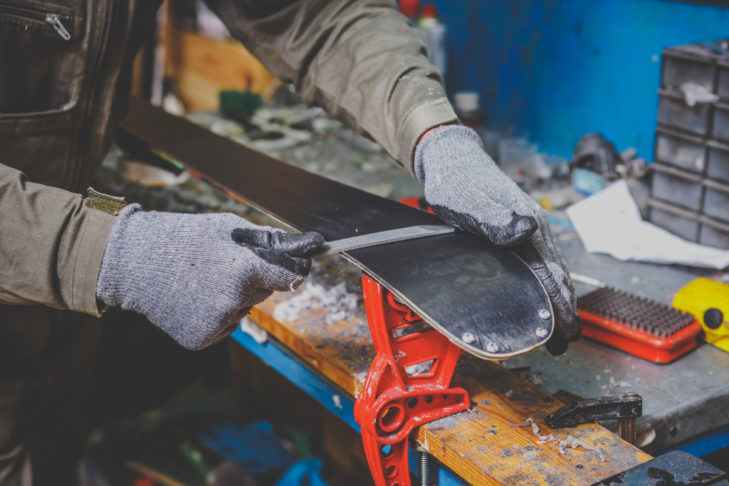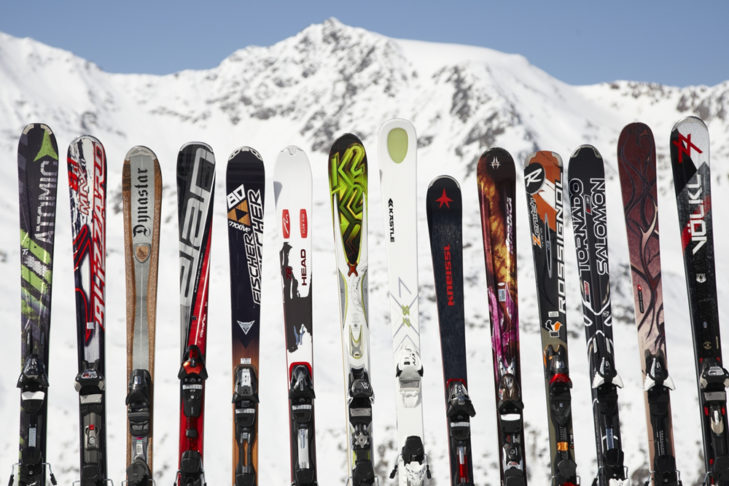“A well maintained and cared-for ski is easier to use and also easier to control,” says Andreas König, safety expert at the German Ski Association (DSV). That’s why every winter sports fan should check whether their skis or snowboard are already fit for the pistes before starting their ski holiday. SnowTrex shows you how to repair ski surfaces, sharpen the edges and wax your skis correctly.
The Steps at a Glance
| Step | To Do |
|---|---|
| Step 1 | Repairing the ski surface |
| Step 2 | Grinding the edges |
| Step 3 | Waxing the skis |
Why is Ski Care Important? Instructions & Tips
If you want to avoid stress on the first day of your holiday, you can get your skis in shape before your holiday. An appropriate ski maintenance service to grow and maintain skis in a specialist shop can never hurt: Repairing ski surfaces, waxing skis, sharpening edges… but with the right equipment, you can also do this yourself. The most important steps should be mastered anyway for regular repairs, because this is also absolutely recommendable. The reason for this: the pistes are often so hard, especially due to the use of artificial snow, that the edge grip is reduced after only a few rides. The artificial snow surface acts like sandpaper in relation to the ski surface. The ski surface thus becomes fibrous and skiing becomes difficult. Experts therefore recommend that you re-wax about every three days during your holiday. This makes the skis faster and more turnable. The braking effect of blunt skis or snowboards increases, especially with fresh snow. Worn edges also reduce the grip on icy and hard slopes.
Ski Care Step 1: Reparing the Ski Surface
With a little practice and the right material, everyone can take care of their skis themselves, even repairing minor damage such as marks or scratches in the ski surface. If there are any, this should be the first step in ski care.
Materials Required for Repairing Defects
- Flat storage surface for the skis, ideally including securement possibility
- BaseTex special fleece or baking paper
- Ski surface cleaner or cleaning spirits
- Cloth
- Repair candle or ski repair pencil
- Kitchen blowtorch or lighter
- Body file or fine sandpaper
- Scraper blade or utility knife
- Small clamping band or household rubber band
- Piece of residual wood
- Copper brush
How to Repair Defects
- Place the ski on a large, flat surface.
- Use the scraper blade/utility knife to remove any raised areas around the defect.
- Remove shavings inside the defect with the utility knife.
- Clamp the ski brake away using the clamping rubber.
- Clean the treading surface with a cloth & cleaner.
- Place residual wood on undamaged ski surface (serves as protection) and leave out only the damaged area.
- Heat the damaged area briefly with the torch/lighter. (Attention: If heated for too long, the ski surface will be damaged!)
- Light the repair candle/ski repair pencil so that the material liquefies.
- Apply the liquid drop by drop to the damaged area. Allow to cure for about 10-20 minutes.
- Carefully plane off hardened, excess material with the utility knife.
- Finely sand the affected area with fine sandpaper or a file. When using a file: Wrap the file with baking paper and cut out a small window to file only the area to be treated.
- Use the copper brush to cover a large area of the treading surface again and remove any remaining dirt.
Ski Care Step 2: Sharpening the Edges
After repairing the defects and waxing the skis, the edges are sharpened.
Materials Required for Sharpening the Edges
- Flat storage surface for the skis, ideally including securement possibility
- Sidewall planer
- Edge grinder
- File
- Diamond file
- Aluminium oxide grindstone
How To Sharpen the Edges
- Place the ski on a large, flat surface.
- Go slightly over the edges with the grindstone and polish the surface.
- Remove a piece of the sidewall with the sidewall planer.
- Adjust the edge grinder to the angle of the edge and clamp the file at an angle so that it reaches the steel edge everywhere despite the ski’s waist.
- Move over the edge with an edge grinder from front to back (several times if necessary).
- Finally, polish the edges with a diamond file.
Tips for Sharpening the Edges
There is also a quick solution for sanding edges from time to time: An abrasive rubber block can help a little.
Ski Care Step 3: Waxing Your Own Skis
The fact that skis need to be waxed can be recognised either by the feeling of skiing or by the colour of the surface: well-saturated ski surfaces have an intense colour. So if it becomes “pale”, it’s time to top it up.
Materials Required for Waxing Your Skis
- Flat storage surface for the skis, ideally including securement possibility
- Ski wax (universal wax – see our “tips” below for more info)
- Small clamping band or household rubber band
- Wax remover or cleaning spirits
- Old cloth
- An iron (steam irons are not suitable for waxing! Instead, it is important that the temperature is adjustable and, above all, constant. Ideally, you should use a wax iron).
- BaseTex special fleece or baking paper
- Plastic scraper blade
- Copper brush
- Nylon or horsehair brush
How To Wax Your Skis
- Place the ski on a large, flat surface.
- Use the brush to remove residual dirt: always brush off the skis in the same direction as they move, i.e. from tip to end.
- Remove old ski wax and other residues with wax remover/cleaning spirits and a cloth.
- Melt the wax block with the iron. When using a household iron, it is best to first use the “wool/silk” setting. As soon as the ski wax starts to smoke, reduce the temperature.
- Allow a small amount of ski wax to drip over the entire treading surface and then iron in evenly with an iron. Important: The optimum temperature is 120 degrees Celsius. If the iron is set too hot, or if it does not keep the temperature constant, the ski surface may be damaged. When ironing in the wax, do not exert too much pressure. The iron should be guided evenly over the treading surface in circular movements.
- Take the iron over the ski again, but this time with special fleece or baking paper underneath. This leads to an even wax layer.
- Leave the wax to cool and harden for at least 30 minutes.
- Then remove the excess ski wax from the treading surface and edges with the scraper, moving in the direction of travel – from front to back.
- Expose the structure of the skis or board by using a copper brush.
- Polish with a nylon/horsehair brush.
- Remove dust with a cloth.
Tips for Waxing Skis
It is important that the ski is not too cold when waxing. If, for example, it is stored in a cool cellar, it should be brought into a warm apartment a few hours beforehand. Only when it is warm do the pores of the material open so that the ski wax can penetrate deep enough.
A fundamental question is also which ski wax is the right one. The following factors have to be taken into consideration when choosing the right wax: Moisture, snow grain & temperature. Therefore, you will find temperature information on the wax packs. Usually, there are 3 types: for warm temperatures around the freezing point, for medium temperatures down to -10 degrees and for even colder temperatures. If you want to wax your skis some time before your holiday, you can play it safe with the choice of ski wax for medium temperatures or universal wax. If in doubt, ask the specialist in the shop!
In addition to the classic hot wax, there are also cold liquid and express waxes for quick repairs in between. These can, of course, be applied faster and with less equipment. The disadvantage, however, is that they wear out faster and do not match the abrasion resistance of hot wax.
Conclusion
Fill in defects, wax & sand edges: With a little practice, the right material and a little patience, everyone can wax and maintain their skis themselves. If necessary, there are also ski service experts in the sports shops. It is also helpful if the skis or snowboard are not only cared for, but also treated with care. After use, for example, they should ideally be dried with a cotton cloth. If you use ski clips or straps, you will prevent the ski surface from rubbing. Last but not least, you should not knock the end of the ski on the ground to remove the snow. This can cause burrs in the end area.








